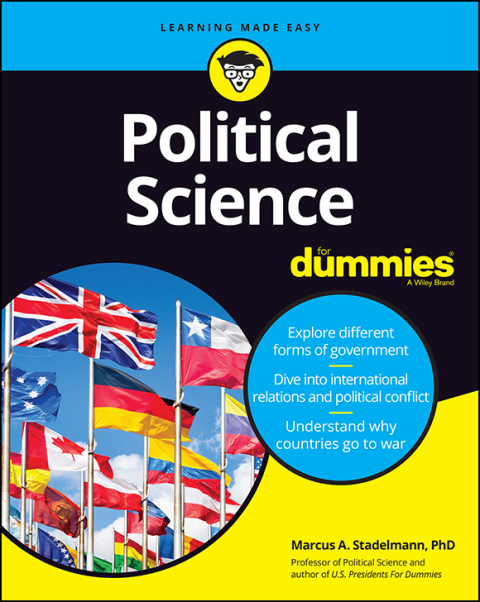Description
Efnisyfirlit
- Cover
- Introduction
- About This Book
- Conventions Used in This Book
- Icons Used in This Book
- Beyond the Book
- Where to Go from Here
- Part 1: Understanding Political Science
- Chapter 1: Discovering the Discipline of Political Science
- Looking at Politics and Political Science
- Studying Political Power
- Searching for Sources of Legitimacy
- Chapter 2: Shaping Research in Political Science: Looking at Major Approaches
- Starting with Traditionalism
- Switching to Behavioralism
- Moving Leftward with Post-Behavioralism
- Comparing Political Science Theories
- Looking at Historical Sociology
- Seeking Benefits: Rational Choice Theory
- Chapter 3: Dealing with Political Culture
- Analyzing Political Culture
- Sustaining Democracy: The Civic Culture
- Working on Political Socialization
- Moving from Materialist to Postmaterialist
- Part 2: Comparing Governments
- Chapter 4: Discussing Different Forms of Government
- Identifying Types of Governments
- Dividing Powers
- Chapter 5: Setting the Rules: Constitutions
- Looking at Constitution Basics
- Creating a New Country: The U.S. Constitution of 1789
- Checking on a New Document: The Russian Constitution
- Chapter 6: Comparing Political Institutions: Systems of Government
- Comparing Democratic Political Systems
- Studying the U.S. Congress
- Looking at Great Britain
- Analyzing Executives
- Going Bureaucratic
- Settling Disputes
- Chapter 7: Elections, Political Parties, and Interest Groups
- Studying Elections
- Political Parties — Necessary for Democracy
- Interest Groups: Influencing the Government
- Part 3: Going Global: International Relations
- Chapter 8: Thinking Globally: The Study of International Relations
- Understanding the Origins of International Relations
- Getting into the Theories of International Relations
- Getting Real: The Power of Realism
- Doing Good: Idealism
- Being Equal through Global Humanism
- Striving for Change with Constructivism
- Chapter 9: Creating Some Order: International Law and Diplomacy
- Defining International Law
- Studying Sources of International Law
- Connecting with Diplomacy
- Chapter 10: Creating Order through International Organizations
- Getting Together in Europe — The Concert of Europe
- Calling for a League of Nations
- Needing a United Nations
- Chapter 11: Not Going to War: The Cold War 1946–1991
- Explaining the Cold War
- Highlighting the Cold War
- Analyzing Strategic Doctrines and the Arms Race
- Chapter 12: Dealing with Political Violence: War and Terrorism
- Examining Warfare
- Looking at the Causes of War
- Dealing with Terrorism
- Going to War with Evil
- Exploring the Costs of War
- Chapter 13: Mixing Disciplines: International Political Economy
- Fusing Economics and Politics
- Creating a New Economic Order
- Discovering Economic Theories
- Examining Population and the Division of Wealth
- Causing Economic Decline in the Third World
- Seeking Globalization: An Integration of Countries
- Part 4: Going from Classical to Modern Political Ideologies
- Chapter 14: Starting in Greece: The Roots of Political Science
- Studying Ancient Greece and the Start of Political Science
- Questioning Everything: Socrates
- Putting Political Philosophy into Play: Plato
- Seeking a Scientific Approach: Aristotle
- Putting Ethics to Use
- Chapter 15: Going Modern: Middle Ages to the Present
- Taking a Lesson on Catholic Theory
- Understanding Power
- Moving to Classical Conservatism
- Advocating for Classical Liberalism
- Putting the Government Back in Charge: Modern Liberalism
- Chapter 16: Moving to the Right: Fascism, Neofascism, and Right-Wing Populism
- Getting a Sense of Fascism
- Starting Out: The Beginnings of Fascism
- Rising of Neofascism
- Challenging the Elite: Populism
- Swinging Right: Right-Wing Populism in Europe
- Chapter 17: Going Left: Communism, Socialism, and Social Democracy
- Causing Socialism
- Starting with Karl Marx
- Updating Marxism: Lenin
- Traveling to Asia: Maoism
- Going Democratic: Social Democracy
- Part 5: The Part of Tens
- Chapter 18: Ten Political Science Books Everyone Should Read
- Politics (335–323 BCE)
- The Prince (1513)
- Leviathan (1651)
- Two Treatises of Government (1690)
- The Wealth of Nations (1776)
- The Communist Manifesto (1848)
- The American Voter (1960)
- Man, the State, and War (1959)
- Who Governs? (1961)
- Who’s Running America? (8th Edition, 2017)
- Chapter 19: Ten Modern Political Scientists
- David Easton
- Gabriel Almond
- Hans Morgenthau
- Kenneth Waltz
- Vladimir Orlando Key
- Samuel P. Huntington
- John Rawls
- Francis Fukuyama
- Robert Gilpin
- Robert O. Keohane
- Index
- About the Author
- Advertisement Page
- Connect with Dummies
- End User License Agreement







Reviews
There are no reviews yet.